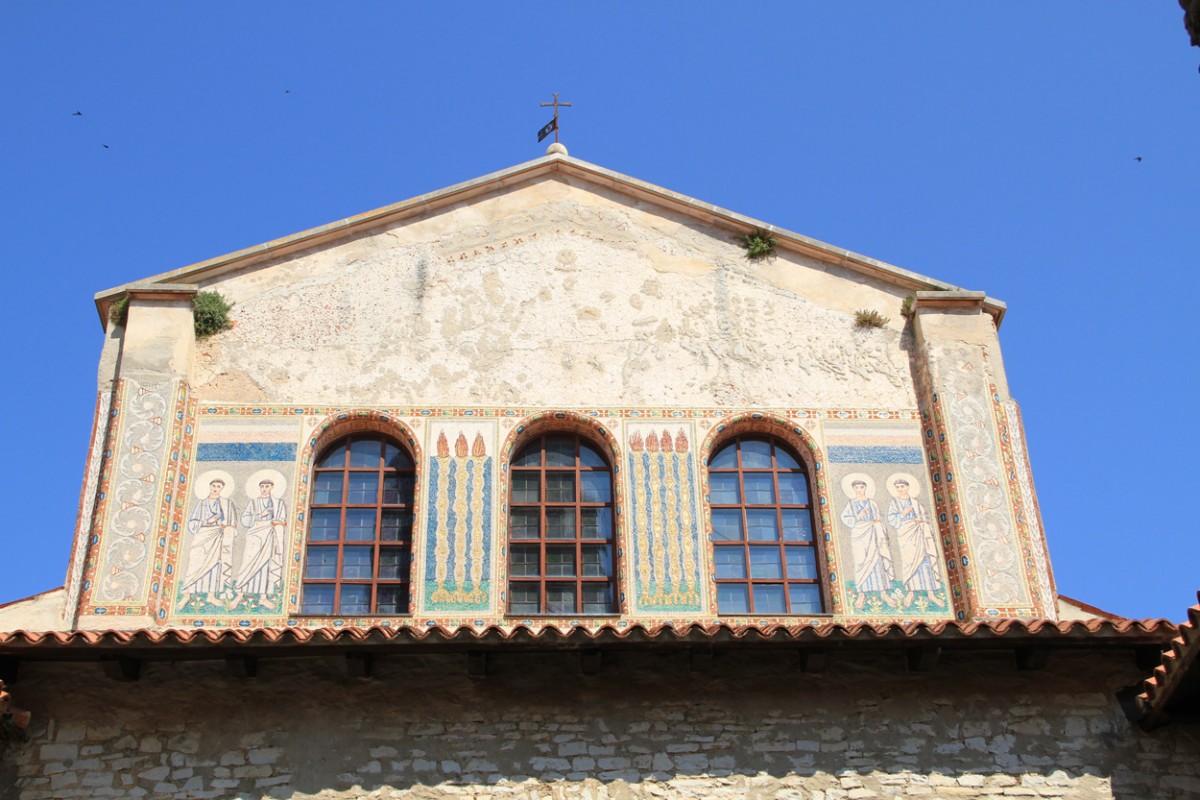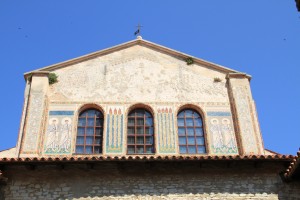The Euphrasian Basilica in Poreč located on the coast of the northern peninsula Istria consists of – apart from the Basilica itself – a sacristy, a baptistery and the bell tower of the nearby archbishop’s palace. The complex is one of the best examples of early Byzantine architecture in the Mediterranean region.
The Euphrasian basilica has for the most part retained its original shape, but accidents, fires and earthquakes have altered a few details. Since it is the third church to be built on the same site, it conceals previous buildings, for example the great floor mosaic of the previous basilica from the 5th century. Because of its exceptional value, it has been inscribed on the UNESCO World Heritage List since 1997. The Basilica is also the Cathedral of the Roman Catholic Diocese of Poreč-Pula.
The earliest basilica was dedicated to St. Maurus of Parentium and dates back to the second half of the 4th century. The floor mosaic from its oratory, originally part of a large Roman house, is still preserved in the church garden! This oratorium was already expanded in the same century into a church composed of a nave and one aisle – the fish on the floor mosaic dates from this period, and coins with the portrayal of emperor Valens (365–378), found in the same spot, confirm these dates.
The present basilica, dedicated to Mary, was built in the sixth century during the period of Bishop Euphrasius, it was built from the year 553 onward on the site of the older basilica, that had become dilapidated. For the construction, parts of the former church were used and the marble blocks were imported from the coast of the Sea of Marmara – the inland sea that connects the Black Sea to the Aegean Sea. The wall mosaics were made by Byzantine masters and the floor mosaics by local experts, with a representation of Euphrasius, holding the church in his arms, on one of the mosaics on the apse.
A novelty of the Euphrasian basilica is that rather than being enclosed by a straight wall, as all sacred buildings were up to that time, it makes use of the breadth and length of the apse of the central nave, built in the shape of a polygon from the outside, whilst the two aisles end in smaller semicircular apses, hollowed into the wall. Making the Euphrasian basilica the earliest example of a triple-apsed church in Western Europe. The atrium is a typical example of Byzantine architecture, as are the columns, the tiles on the altar rail and all the abundant mosaics. Most impressive is the representation of Christ with the apostles, and beneath it a frieze of 13 medallions with a picture of Christ as the Lamb in the centre, surrounded by 12 medallions depicting various martyrs.
The most striking feature of the basilica are its mosaics, dating from the 6th century, and which are considered amongst the finest examples of Byzantine art in the world.
The mosaics in the triumphal arch over the apse represent Christ – holding an opened book with the text “Ego sum Lux vera” (I am the true light) with the Apostles. The arch below contains mosaic medallions with the Lamb of God and portraits of twelve female martyrs. The vault over the apse is decorated with mosaics with Mary and Child, sitting on the Heavenly throne, under a wreath held by a hand – symbol of God the Father. This is the only surviving depiction of the Mother of God in an early-Christian western basilica. She is flanked by angels, Bishop Euphrasius, holding the model of the church; also local saints are depicted, including St. Maurus, the first bishop of Poreč and the Istrian diocese, and the archdeacon Claudius.
Opening hours
January – March 09.00 – 16.00
April – June 09.00 – 18.00
July – August 09.00 – 21.00
September – October: 09.00 – 18.00
November – December 09.00 – 16.00
Closed on Sundays and church holidays
Address
Eufrazijeva ulica 22, Porec
Contact
telephone +385 52 451784
e-mail kancelar@ppb.hr


